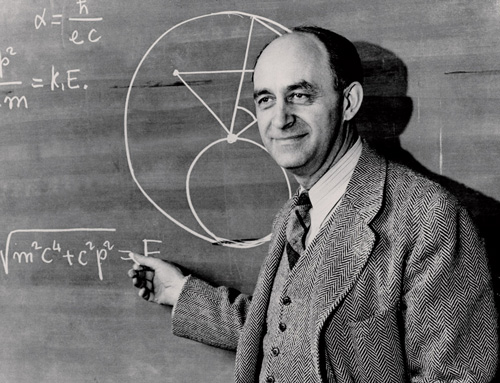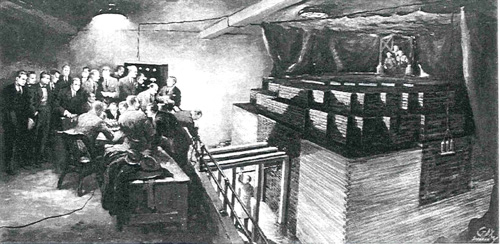A genial experimenter and theoretician
Enrico Fermi (Rome, September 29, 1901 – Chicago, November 29, 1954) was a genial physicist. Talented experimenter, he knew how to interpret the experimental results he had obtained through theory.

Enrico Fermi
Enrico Fermi was both a great experimenter and a great theorist
© Atomic Archives
In 1927, he introduced the Fermi-Dirac statistics which governs the behavior of “spin 1/2” particles such as electrons or protons (later called fermions from his name). It was the result of his research on particles behavior in an ideal gas.
In 1934 taking seriously the invention of the Wolfgang Pauli’s “neutrino”, he developed the theory of “beta-minus” disintegrations assuming that this phenomenon is due to the transformation inside the atomic nucleus, of a neutron into a proton accompanied by the creation of an electron-neutrino pair.
With a talented team of young physicists in Rome (the “ragazzi of Panisperna”), knowing that the neutron which has no electric charge can penetrate more easily into nuclei than alpha particles, he was the first to produce large quantities of artificial radionuclei. They also tried to produce transuranic elements, beyond uranium.
Fermi’s group enjoys great prestige and ingratiated Mussolini for a while.
However, the attempt to create a competitive Research Center collapses, the political climate becomes more and more oppressive. In 1938, Enrico Fermi was awarded the Nobel Prize. He went to Stockholm to receive it, but did not return to Italy. His wife was Jewish and they feared what could happen under Mussolini’s regime. They left to the United States.

Fermi and the Chicago atomic pile
The Chicago pile, the first atomic pile in the world and the first to achieve a self-sustaining and controlled chain reaction , was designed by Enrico Fermi and his team as part of the Manhattan Project that would lead to the atomic bomb in 1945 . The atomic pile, ancestor of our nuclear reactors, was built in 1942 under the stands of the American football stadium at the Chicago University. On 2 December 1942, the team led by Fermi triggered the first nuclear fission chain reaction by withdrewing from the pile a cadmium coated control bar, .
© AtomicArchives
Enrico Fermi was involved in the Manhattan Project led by Robert Oppenheimer during the Second World War. He participates in the conception of the first atomic bomb dropped on Hiroshima, on August 6, 1945. On August 9 a second bomb, based on plutonium, was dropped on Nagasaki.
On august 28, Fermi wrote a long letter to Eduardo Amaldi, remained in Italy, “It was a work of great scientific interest and having helped end a war that threatened to go on for months even years has undoubtedly been a source of satisfaction. ”
Enrico Fermi contributed also to the conception of the H-bomb by the United States.
After the war, although remaining in the United States, Fermi devoted himself to research. He founded a new school of physics in Chicago. He had close relationships with the Italian physicists and assisted in the rebuilding of Italian physics. One can say that there exists a Fermi’s school, characterized by close association between experimenters and theoreticians.
Other articles on the subject « Discoveries »
Marie Curie
Marie Sklodowska-Curie had an exceptional destiny. Born in Poland, she came to graduate school in[...]
Three radiations
Understanding the nature of alpha, beta and gamma rays In the years following the discovery of ra[...]
Discovery of the Nucleus
A new vision of the atom In 1911, Rutherford, Marsden and Geiger discovered the dense atomic nucl[...]
Ernest Rutherford
In October 1895, landed in England a 24 years-old young New Zealander. His name was Ernest Ruther[...]
Rutherford’s experiment
The experiment which proved the existence of a nucleus in the atom In 1908, Ernest Rutherford rec[...]
The neutron : Chadwick
A close competition between great physicists … James Chadwick, who discovered the neutron i[...]
Radium and Medicine
A short history: first steps in nuclear medicine … Everyone knows that the discovery of rad[...]
1934 : Artificial Radioactivity
The production at will of radioactive isotopes In the first days of 1934, Frederic and Irene Joli[...]
The Neutrino Hypothesis
The remarkable story of the neutrino The study of radioactive disintegrations had established tha[...]
Fission discovery
A nuclear phenomenon that escaped the hands of physicists In the years spanning 1934 to 1938, Enr[...]